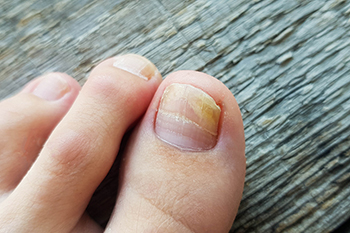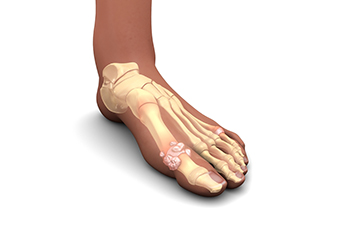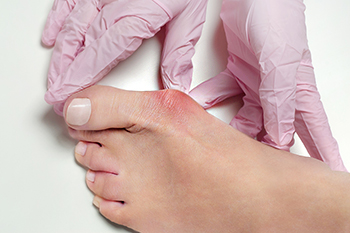July 2024
Why Live with Pain and Numbness in Your Feet?
Symptoms and Risk Factors for Toenail Fungus

Toenail fungus, also known as onychomycosis, is a fungal infection affecting the toenails. It typically begins as a white or yellow spot under the tip of the nail and can spread deeper into the nail over time, causing discoloration, thickening, and crumbling of the nail edges. Risk factors for toenail fungus include frequent exposure to warm and moist environments such as public showers, wearing tight-fitting shoes, and having a weakened immune system. Symptoms may include a foul odor from the infected nail, pain or discomfort, and difficulty trimming the nail due to its thickness. If left untreated, toenail fungus can lead to permanent damage to the nail bed and spread to other nails or skin. The chances of recovery increase when treated early. If you have toenail fungus, it is suggested that you contact a podiatrist where you can receive expert treatment for this condition.
If left untreated, toenail fungus may spread to other toenails, skin, or even fingernails. If you suspect you have toenail fungus it is important to seek treatment right away. For more information about treatment, contact Dr. Ronald K. Olm of Grand Traverse Foot & Ankle Center. Our doctor can provide the care you need to keep you pain-free and on your feet.
Symptoms
- Warped or oddly shaped nails
- Yellowish nails
- Loose/separated nail
- Buildup of bits and pieces of nail fragments under the nail
- Brittle, broken, thickened nail
Treatment
If self-care strategies and over-the-counter medications does not help your fungus, your podiatrist may give you a prescription drug instead. Even if you find relief from your toenail fungus symptoms, you may experience a repeat infection in the future.
Prevention
In order to prevent getting toenail fungus in the future, you should always make sure to wash your feet with soap and water. After washing, it is important to dry your feet thoroughly especially in between the toes. When trimming your toenails, be sure to trim straight across instead of in a rounded shape. It is crucial not to cover up discolored nails with nail polish because that will prevent your nail from being able to “breathe”.
In some cases, surgical procedure may be needed to remove the toenail fungus. Consult with your podiatrist about the best treatment options for your case of toenail fungus.
If you have any questions, please feel free to contact one of our offices located in Traverse City and Kalkaska, MI . We offer the newest diagnostic and treatment technologies for all your foot care needs.
Effective Strategies for Relieving Gout Pain

Gout is a form of arthritis characterized by sudden, severe attacks of pain, redness, and swelling in joints, often caused by an excess of uric acid in the blood. Relieving gout pain involves a combination of medication and lifestyle changes. Nonsteroidal anti-inflammatory drugs, corticosteroids, and colchicine can help reduce inflammation and alleviate pain. Staying well-hydrated by drinking plenty of water can help to flush uric acid from the body, potentially preventing future attacks. Resting the affected joint and keeping it elevated can also provide relief. Dietary changes, such as reducing intake of purine-rich foods like red meat, shellfish, and alcohol, may help to lower uric acid levels. Consuming cherries or cherry juice has been shown to reduce gout flare-ups. Maintaining a healthy weight through regular exercise and a balanced diet can further help manage gout symptoms. Gout can severely hinder daily life. If you have had one or more gout attacks, it is strongly suggested that you are under the care of a podiatrist who can offer you effective relief and treatment strategies.
Gout is a foot condition that requires certain treatment and care. If you are seeking treatment, contact Dr. Ronald K. Olm from Grand Traverse Foot & Ankle Center. Our doctor will treat your foot and ankle needs.
What Is Gout?
Gout is a type of arthritis caused by a buildup of uric acid in the bloodstream. It often develops in the foot, especially the big toe area, although it can manifest in other parts of the body as well. Gout can make walking and standing very painful and is especially common in diabetics and the obese.
People typically get gout because of a poor diet. Genetic predisposition is also a factor. The children of parents who have had gout frequently have a chance of developing it themselves.
Gout can easily be identified by redness and inflammation of the big toe and the surrounding areas of the foot. Other symptoms include extreme fatigue, joint pain, and running high fevers. Sometimes corticosteroid drugs can be prescribed to treat gout, but the best way to combat this disease is to get more exercise and eat a better diet.
If you have any questions please feel free to contact one of our offices located in Traverse City and Kalkaska, MI . We offer the newest diagnostic and treatment technologies for all your foot and ankle needs.
What Are Diabetic Foot Ulcers?

Diabetic foot ulcers are serious complications of diabetes, characterized by open sores or wounds that typically develop on the feet. They result from poor circulation, nerve damage, also called neuropathy, and impaired immune function associated with diabetes. Treatment involves meticulous wound care, which includes cleaning the ulcer with gentle soap and water, applying antibiotic ointment, and covering it with a sterile dressing. Offloading pressure from the affected foot is important to prevent further irritation and aid healing. Podiatrists can conduct regular exams to monitor ulcers, assess circulation, and provide guidance on footwear and hygiene. Timely intervention can prevent complications such as infections or amputations. If you have diabetes, it is strongly suggested you visit a podiatrist who can help you to manage this condition.
Wound care is an important part in dealing with diabetes. If you have diabetes and a foot wound or would like more information about wound care for diabetics, consult with Dr. Ronald K. Olm from Grand Traverse Foot & Ankle Center. Our doctor will assess your condition and provide you with quality foot and ankle treatment.
What Is Wound Care?
Wound care is the practice of taking proper care of a wound. This can range from the smallest to the largest of wounds. While everyone can benefit from proper wound care, it is much more important for diabetics. Diabetics often suffer from poor blood circulation which causes wounds to heal much slower than they would in a non-diabetic.
What Is the Importance of Wound Care?
While it may not seem apparent with small ulcers on the foot, for diabetics, any size ulcer can become infected. Diabetics often also suffer from neuropathy, or nerve loss. This means they might not even feel when they have an ulcer on their foot. If the wound becomes severely infected, amputation may be necessary. Therefore, it is of the upmost importance to properly care for any and all foot wounds.
How to Care for Wounds
The best way to care for foot wounds is to prevent them. For diabetics, this means daily inspections of the feet for any signs of abnormalities or ulcers. It is also recommended to see a podiatrist several times a year for a foot inspection. If you do have an ulcer, run the wound under water to clear dirt from the wound; then apply antibiotic ointment to the wound and cover with a bandage. Bandages should be changed daily and keeping pressure off the wound is smart. It is advised to see a podiatrist, who can keep an eye on it.
If you have any questions, please feel free to contact one of our offices located in Traverse City and Kalkaska, MI . We offer the newest diagnostic and treatment technologies for all your foot care needs.
Stiff Big Toe Pain
 Hallux rigidus, or stiff big toe, is a form of arthritis affecting the joint at the base of the big toe, leading to pain and stiffness. This condition occurs due to the wear and tear of the cartilage in the joint, which can be accelerated by repetitive stress, injury, or genetic predisposition. It commonly affects adults over 30, especially those with a history of foot injuries, or occupations that place significant stress on the feet. Symptoms can include pain and stiffness in the big toe during movement, swelling surrounding the joint, and difficulty in bending the toe. Over time, bone spurs may develop, further limiting motion and causing discomfort. Complications of untreated hallux rigidus can include chronic pain, difficulty walking, and an altered gait, leading to additional foot, knee, hip, or back problems. Prevention involves wearing supportive shoes with a wide toe box, avoiding high heels, and performing foot exercises to maintain flexibility. Treatment options range from non-surgical methods, such as anti-inflammatory medications, orthotics, and targeted stretching exercises, to surgical intervention, in severe cases. If you have a stiff and painful big toe, it is suggested that you schedule an appointment with a podiatrist for an accurate diagnosis and effective treatment.
Hallux rigidus, or stiff big toe, is a form of arthritis affecting the joint at the base of the big toe, leading to pain and stiffness. This condition occurs due to the wear and tear of the cartilage in the joint, which can be accelerated by repetitive stress, injury, or genetic predisposition. It commonly affects adults over 30, especially those with a history of foot injuries, or occupations that place significant stress on the feet. Symptoms can include pain and stiffness in the big toe during movement, swelling surrounding the joint, and difficulty in bending the toe. Over time, bone spurs may develop, further limiting motion and causing discomfort. Complications of untreated hallux rigidus can include chronic pain, difficulty walking, and an altered gait, leading to additional foot, knee, hip, or back problems. Prevention involves wearing supportive shoes with a wide toe box, avoiding high heels, and performing foot exercises to maintain flexibility. Treatment options range from non-surgical methods, such as anti-inflammatory medications, orthotics, and targeted stretching exercises, to surgical intervention, in severe cases. If you have a stiff and painful big toe, it is suggested that you schedule an appointment with a podiatrist for an accurate diagnosis and effective treatment.
Arthritis can be a difficult condition to live with. If you are seeking treatment, contact Dr. Ronald K. Olm from Grand Traverse Foot & Ankle Center. Our doctor can provide the care you need to keep you pain-free and on your feet.
Arthritic Foot Care
Arthritis is a term that is commonly used to describe joint pain. The condition itself can occur to anyone of any age, race, or gender, and there are over 100 types of it. Nevertheless, arthritis is more commonly found in women compared to men, and it is also more prevalent in those who are overweight. The causes of arthritis vary depending on which type of arthritis you have. Osteoarthritis for example, is often caused by injury, while rheumatoid arthritis is caused by a misdirected immune system.
Symptoms
- Swelling
- Pain
- Stiffness
- Decreased Range of Motion
Arthritic symptoms range in severity, and they may come and go. Some symptoms stay the same for several years but could potentially get worse with time. Severe cases of arthritis can prevent its sufferers from performing daily activities and make walking difficult.
Risk Factors
- Occupation – Occupations requiring repetitive knee movements have been linked to osteoarthritis
- Obesity – Excess weight can contribute to osteoarthritis development
- Infection – Microbial agents can infect the joints and trigger arthritis
- Joint Injuries – Damage to joints may lead to osteoarthritis
- Age – Risk increases with age
- Gender –Most types are more common in women
- Genetics – Arthritis can be hereditary
If you suspect your arthritis is affecting your feet, it is crucial that you see a podiatrist immediately. Your doctor will be able to address your specific case and help you decide which treatment method is best for you.
If you have any questions, please feel free to contact one of our offices located in Traverse City and Kalkaska, MI . We offer the newest diagnostic and treatment technologies for all your foot care needs.
Facts About Foot Blisters

Foot blisters are small, fluid-filled pockets that form on the upper layers of the skin, typically caused by friction. These blisters often develop due to repetitive rubbing against shoes or socks during activities such as walking, running, or hiking. When the skin experiences constant friction, the outer layer separates from the underlying layers, creating a space that fills with fluid. Moisture from sweat can exacerbate this process, making blisters more likely. Common areas for foot blisters include the heels, toes, and soles. While generally not serious, blisters can be painful and impact mobility. To prevent blisters, it is important to wear well-fitting shoes and moisture-wicking socks, and to keep feet dry. If a blister forms, it should be kept clean and protected to prevent infection and promote healing, and avoiding further irritation is vital for recovery. Foot blisters are often uncomfortable, and can hinder completing daily tasks. If you have a blister on your foot that has become infected, it is suggested that you visit a podiatrist who can offer relief and treatment techniques.
Blisters may appear as a single bubble or in a cluster. They can cause a lot of pain and may be filled with pus, blood, or watery serum. If your feet are hurting, contact Dr. Ronald K. Olm of Grand Traverse Foot & Ankle Center. Our doctor can provide the care you need to keep you pain-free and on your feet.
Foot Blisters
Foot blisters are often the result of friction. This happens due to the constant rubbing from shoes, which can lead to pain.
What Are Foot Blisters?
A foot blister is a small fluid-filled pocket that forms on the upper-most layer of the skin. Blisters are filled with clear fluid and can lead to blood drainage or pus if the area becomes infected.
Symptoms
(Blister symptoms may vary depending on what is causing them)
- Bubble of skin filled with fluid
- Redness
- Moderate to severe pain
- Itching
Prevention & Treatment
In order to prevent blisters, you should be sure to wear comfortable shoes with socks that cushion your feet and absorb sweat. Breaking a blister open may increase your chances of developing an infection. However, if your blister breaks, you should wash the area with soap and water immediately and then apply a bandage to the affected area. If your blisters cause severe pain it is important that you call your podiatrist right away.
If you have any questions, please feel free to contact one of our offices located in Traverse City and Kalkaska, MI . We offer the newest diagnostic and treatment technologies for all your foot care needs.






